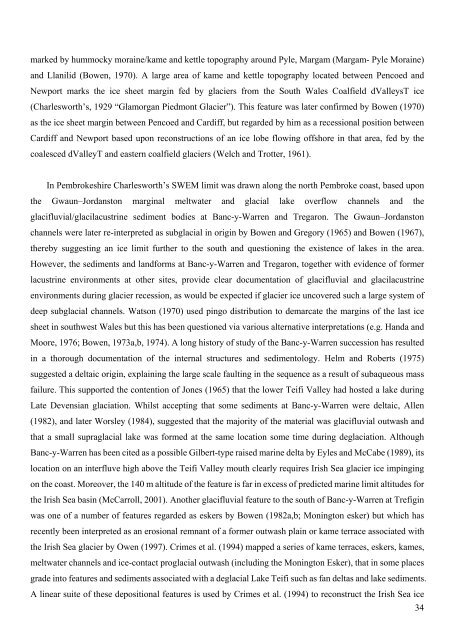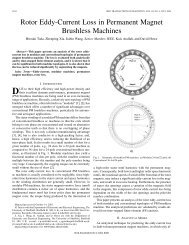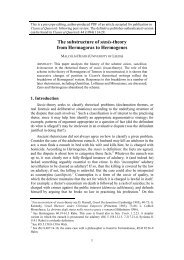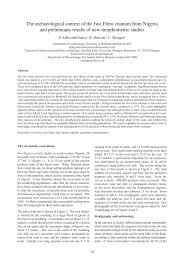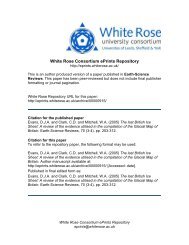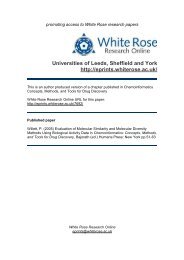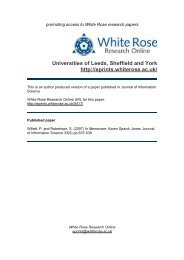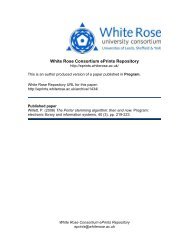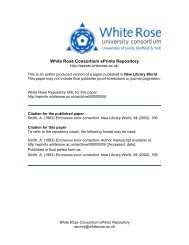The last British Ice Sheet: A review of the evidence utilised in the ...
The last British Ice Sheet: A review of the evidence utilised in the ...
The last British Ice Sheet: A review of the evidence utilised in the ...
You also want an ePaper? Increase the reach of your titles
YUMPU automatically turns print PDFs into web optimized ePapers that Google loves.
marked by hummocky mora<strong>in</strong>e/kame and kettle topography around Pyle, Margam (Margam- Pyle Mora<strong>in</strong>e)<br />
and Llanilid (Bowen, 1970). A large area <strong>of</strong> kame and kettle topography located between Pencoed and<br />
Newport marks <strong>the</strong> ice sheet marg<strong>in</strong> fed by glaciers from <strong>the</strong> South Wales Coalfield dValleysT ice<br />
(Charlesworth’s, 1929 “Glamorgan Piedmont Glacier”). This feature was later confirmed by Bowen (1970)<br />
as <strong>the</strong> ice sheet marg<strong>in</strong> between Pencoed and Cardiff, but regarded by him as a recessional position between<br />
Cardiff and Newport based upon reconstructions <strong>of</strong> an ice lobe flow<strong>in</strong>g <strong>of</strong>fshore <strong>in</strong> that area, fed by <strong>the</strong><br />
coalesced dValleyT and eastern coalfield glaciers (Welch and Trotter, 1961).<br />
In Pembrokeshire Charlesworth’s SWEM limit was drawn along <strong>the</strong> north Pembroke coast, based upon<br />
<strong>the</strong> Gwaun–Jordanston marg<strong>in</strong>al meltwater and glacial lake overflow channels and <strong>the</strong><br />
glacifluvial/glacilacustr<strong>in</strong>e sediment bodies at Banc-y-Warren and Tregaron. <strong>The</strong> Gwaun–Jordanston<br />
channels were later re-<strong>in</strong>terpreted as subglacial <strong>in</strong> orig<strong>in</strong> by Bowen and Gregory (1965) and Bowen (1967),<br />
<strong>the</strong>reby suggest<strong>in</strong>g an ice limit fur<strong>the</strong>r to <strong>the</strong> south and question<strong>in</strong>g <strong>the</strong> existence <strong>of</strong> lakes <strong>in</strong> <strong>the</strong> area.<br />
However, <strong>the</strong> sediments and landforms at Banc-y-Warren and Tregaron, toge<strong>the</strong>r with <strong>evidence</strong> <strong>of</strong> former<br />
lacustr<strong>in</strong>e environments at o<strong>the</strong>r sites, provide clear documentation <strong>of</strong> glacifluvial and glacilacustr<strong>in</strong>e<br />
environments dur<strong>in</strong>g glacier recession, as would be expected if glacier ice uncovered such a large system <strong>of</strong><br />
deep subglacial channels. Watson (1970) used p<strong>in</strong>go distribution to demarcate <strong>the</strong> marg<strong>in</strong>s <strong>of</strong> <strong>the</strong> <strong>last</strong> ice<br />
sheet <strong>in</strong> southwest Wales but this has been questioned via various alternative <strong>in</strong>terpretations (e.g. Handa and<br />
Moore, 1976; Bowen, 1973a,b, 1974). A long history <strong>of</strong> study <strong>of</strong> <strong>the</strong> Banc-y-Warren succession has resulted<br />
<strong>in</strong> a thorough documentation <strong>of</strong> <strong>the</strong> <strong>in</strong>ternal structures and sedimentology. Helm and Roberts (1975)<br />
suggested a deltaic orig<strong>in</strong>, expla<strong>in</strong><strong>in</strong>g <strong>the</strong> large scale fault<strong>in</strong>g <strong>in</strong> <strong>the</strong> sequence as a result <strong>of</strong> subaqueous mass<br />
failure. This supported <strong>the</strong> contention <strong>of</strong> Jones (1965) that <strong>the</strong> lower Teifi Valley had hosted a lake dur<strong>in</strong>g<br />
Late Devensian glaciation. Whilst accept<strong>in</strong>g that some sediments at Banc-y-Warren were deltaic, Allen<br />
(1982), and later Worsley (1984), suggested that <strong>the</strong> majority <strong>of</strong> <strong>the</strong> material was glacifluvial outwash and<br />
that a small supraglacial lake was formed at <strong>the</strong> same location some time dur<strong>in</strong>g deglaciation. Although<br />
Banc-y-Warren has been cited as a possible Gilbert-type raised mar<strong>in</strong>e delta by Eyles and McCabe (1989), its<br />
location on an <strong>in</strong>terfluve high above <strong>the</strong> Teifi Valley mouth clearly requires Irish Sea glacier ice imp<strong>in</strong>g<strong>in</strong>g<br />
on <strong>the</strong> coast. Moreover, <strong>the</strong> 140 m altitude <strong>of</strong> <strong>the</strong> feature is far <strong>in</strong> excess <strong>of</strong> predicted mar<strong>in</strong>e limit altitudes for<br />
<strong>the</strong> Irish Sea bas<strong>in</strong> (McCarroll, 2001). Ano<strong>the</strong>r glacifluvial feature to <strong>the</strong> south <strong>of</strong> Banc-y-Warren at Trefig<strong>in</strong><br />
was one <strong>of</strong> a number <strong>of</strong> features regarded as eskers by Bowen (1982a,b; Mon<strong>in</strong>gton esker) but which has<br />
recently been <strong>in</strong>terpreted as an erosional remnant <strong>of</strong> a former outwash pla<strong>in</strong> or kame terrace associated with<br />
<strong>the</strong> Irish Sea glacier by Owen (1997). Crimes et al. (1994) mapped a series <strong>of</strong> kame terraces, eskers, kames,<br />
meltwater channels and ice-contact proglacial outwash (<strong>in</strong>clud<strong>in</strong>g <strong>the</strong> Mon<strong>in</strong>gton Esker), that <strong>in</strong> some places<br />
grade <strong>in</strong>to features and sediments associated with a deglacial Lake Teifi such as fan deltas and lake sediments.<br />
A l<strong>in</strong>ear suite <strong>of</strong> <strong>the</strong>se depositional features is used by Crimes et al. (1994) to reconstruct <strong>the</strong> Irish Sea ice<br />
34


